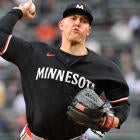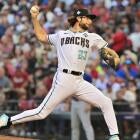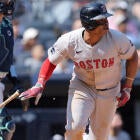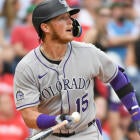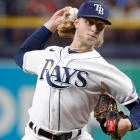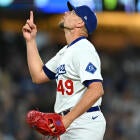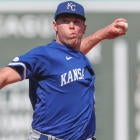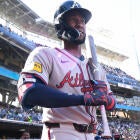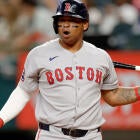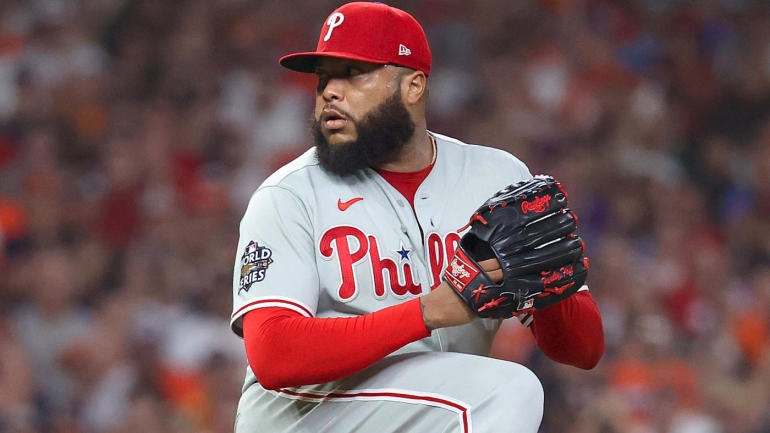
There just isn't typically a ton we can learn from the first weekend of the season. We're typically looking for dozens of games worth of opportunities to learn new things about players, and as of publication, no team save for the Cubs has even played more than four games, and they've only played five. There just isn't enough information to go on here.
But that's not 100% true. Injuries, of course, can change how we feel about a player after just a weekend, and how managers choose to use players can, too. And that's especially true for closers, whose value in Fantasy comes almost entirely from how their managers choose to use them.
We entered the season with around 20 "stable" closer situations around MLB, and for the most part, nothing has changed there. And there are some unsettled situations who we still don't have a good sense of – the Tigers, to name one team, swept in their three-game series against the Dodgers, and they only really had one save situation, in the 10th inning Friday, when Beau Briske gave up five runs (four earned) while recording just one out. That might make it less likely that Briske gets the next save chance, whenever it comes, but the fact that Tommy Kahnle was used in the bottom of the ninth of a tied game could mean he's the closer, despite Briske actually getting the save opportunity.
So there are only a handful of situations where we got a real sense of who might be the closer, and Fantasy players will surely be chasing them when waivers run this week. So, before we get to every position's top targets, a quick rundown of four relievers to target for saves this weekend.
Before we move on, I do want to highlight David Bednar, who entered the season as the Pirates closer but might already be out of a job after he allowed three earned runs while taking two losses across three of the season's first four games. That would seem to be enough to put his job in jeopardy, but the Pirates seemed especially unprepared for the possibility of their closer imploding, as Bednar is surrounded by a motley crew of journeymen, none of whom seems especially likely to thrive in a high-pressure environment. Colin Holderman worked three of the first four games but gave up runs in two of them, so I wouldn't expect them to turn to him; Caleb Ferguson worked the eighth ahead of Bednar Sunday, but as a lefty, he may not be an ideal choice; Dennis Santana has closer stuff, but also has a career 4.73 ERA.
Which is to say, while Bednar seems likely to have already lost his job, I'm not sure there's a good target to consider in this bullpen. I'd rather wait to see who gets the next save here, rather than trying to get ahead of a situation where there might not be any good options.
Relievers to target
- Jose Alvarado, Phillies (20%) – The Phillies only got one save chance this weekend, and it was actually Matt Strahm who got it in extras on Opening Day. But Alvarado worked the ninth in that one with the game tied, with Orion Kerkering and Jordan Romano taking the seventh and eighth innings. And it's not like the lineup was stacked with lefties when he came on, so this might be the way they were leaning – there were multiple games in Spring Training when they used this same configuration, too. I'm not at all confident that Alvarado is going to get the next save for the Phillies, but he should get some saves, and he'll be very good along the way, making him worth targeting ahead of the fringier talents on the list.
- Luke Jackson, Rangers (28%) – How about this for a vote of confidence: Jackson gave up a three-run homer to lose the game on Opening Day, only for the Rangers to go right back to him for saves Friday and Sunday. Chris Martin got the save Sunday, but that was with Jackson unavailable; he set up for Jackson in the two games he saved. That doesn't guarantee Jackson will be the closer moving forward – or that he'll hang on to the job even if he is – but he feels like a pretty good bet to get the next one, at least.
- Seth Halvorsen, Rockies (9%) – There won't be a ton of save chances for the Rockies, but Halvorsen got the first one of the season, working 1.1 innings to close out the win over the Rays Saturday. Halvorsen has big stuff, but he also pitches half his games at Coors Field, which makes it hard to get too excited about him. But saves are saves.
- Emilio Pagan, Reds (3%) – After Ian Gibaut – it's fine if you don't recognize the name, I don't think you're going to need it moving forward – blew a save on Opening Day, Terry Francona said he probably should have used Gibaut in the seventh inning and Pagan in the ninth. He did use Pagan to get the final three outs in the team's lone win so far, so that seems like where he's leaning. For now. Pagan is a flyball pitcher in the most homer-friendly park in baseball, so I wouldn't want to stake my reputation on him being a shutdown closer, certainly. But Francona seems to be leaning that way, and that's the more important factor for now. I'm ranking him last here because he's the most likely to make his real-life manager rethink this arrangement.
I'll also mention Camilo Doval here. Not because he needs to be a high-priority add, but because he's a name you need to keep in the back of your head. Ryan Walker missed Sunday's game with back tightness, which gave Doval the chance to work a clean ninth for the save against the Reds. Walker is expected back Monday, but Doval looms as a former All-Star who could still be a dominant force in the late innings if something goes wrong for Walker.
Here's who else I'm looking to add this week.
Week 2 Waiver Targets
Catchers
Hunter Goodman, Rockies (14%) – We expected Goodman to be the backup catcher for the Rockies this season, but there he was in the lineup for the first two games, while Jacob Stallings watched from the bench. And then, when Stallings finally started Sunday's game, who was in at DH for the Rockies – and batting cleanup, no less? Yep, Goodman was in there for each of the first three games of the season. It may not mean anything for his playing time moving forward, but we're talking about a guy with 44 career homers in 149 games across Double-A and Triple-A and he's catcher eligible. I'm adding him everywhere I need a No. 2 catcher.
Deep-league target: Endy Rodriguez, Pirates (7%) – Another guy who unexpectedly has at least an early-season path to a lot of playing time, Rodriguez started two of the first three games of the season for the Pirates, two at first base. A former top prospect, Rodriguez looks like he'll be a big part of the team's plans until at least Spencer Horwitz is ready to come back from his wrist injury. Worth a look in deeper, two-catcher leagues.
First Base
Ben Rice, Yankees (40%) – There's no shortage of interesting first basemen in this roster rate range, so if you prefer Spencer Torkelson or Tyler Soderstrom or even the DH-only (for now) Kyle Manzardo, I wouldn't argue with you too much. But I really like Ben Rice, who was hitting the ball harder than ever before this spring and hit his first homer of the season Sunday. There might be some platoon usage at first, which could be a reason to prioritize Torkelson especially. But I love Rice's fit in his home park and I'm willing to prioritize him.
Deep-league target: Gavin Sheets, Padres (6%) – Sheets didn't start on Opening Day, but he did come in to homer as a pinch-hitter, and then he started each of the next three games. Sheets might be just a platoon bat, but he has some pop and played his way onto the roster with a big spring, so I'm a little big intrigued to see if he can carry it over.
Second base
Gavin Lux, Reds (24%) – The Reds might have some tough decisions to make about their lineup when Austin Hays is healthy enough to play, but that might not happen until next week, so Lux has a little bit of runway to play with. He showed surprising upside with a swing change in the second half of last season and has a valuable spot in the lineup in a very good home park, so I'm willing to give him a chance if I need a second baseman.
Deep-league target: Ryan Bliss, Mariners (6%) – I think it's unlikely we get much production from Bliss, who probably strikes out a bit too much for having such middling power. But he has been a productive hitter in the high minors and brings plenty of speed to the table, including two steals in the first three games this season. If you need speed in a deeper league, he's a very cheap option to consider.
Third base
Joseph Ortiz, Brewers (33%) – Ortiz didn't really do anything this weekend to justify much hype, but he also didn't do anything to be less interesting than he was before. And he was moderately interesting after having 11 steals and 11 homers in 511 plate appearances last season. There's probably room to improve on both numbers as a full-time player, making him a viable CI or MI option in Roto leagues, at least. If you need more speed, you could consider Isiah Kiner-Falefa, who stole three bases in the first four games, though that might be more of a Marlins issue than a trend IKF can keep up, as the Pirates stole 14 bases in the series.
Deep-league target: Gabriel Arias, Guardians (3%) – Arias was one of the biggest bat-speed gainers in the league this spring, and he put that in play Sunday as he hit his first homer of the season. It's early, but his 96.5 mph average exit velocity on his first six batted balls could be early evidence that his swing change is paying off.
Shortstop
Jacob Wilson, Athletics (36%) – Through his first 15 plate appearances, Wilson has yet to strike out. If he's going to succeed in the majors, it's going to be because he makes outrageous amounts of contact, and that's what we're seeing so far. He will, at some point, have to make damage when he makes contact, something we've seen less of so far. Hopefully that'll come, and I'm still willing to bet on the outlier contact skill if I need help in the middle infield.
Deep-league targets: Max Muncy, Athletics (9%) – Muncy started the first three games of the season before getting a day off Sunday, and I suspect that's all it was – a day off for a rookie in his first series. Until Zack Gelof returns from his hand injury, I think we're going to see Muncy in there more or less everyday, and I'd rather bet on there being some upside here than some of the also-rans at the position who are this widely available.
Outfield
Victor Scott, Cardinals (50%) – I don't expect much power from Scott, but it was surprisingly a part of his game this spring. And then he went out and hit his first homer of the season Sunday against Bailey Ober, a very good pitcher. He added another 105.2 mph lineout Sunday, so it wasn't just a one-off thing here. The primary appeal for Scott is going to be the speed, and the good news is, he's contributing there already, with three steals in as many games. He might just be figuring it out after looking largely overwhelmed last season.
Tommy Pham, Pirates (29%) – It's boring, but Pham is usually at least an average bat and he's hitting leadoff. Last season, "average" would have been an improvement, but he still has a bit of pop and speed – and two years ago, he had 16 homers and 22 steals, so it's not like there's zero upside here. Usually, leadoff hitters aren't this widely available in Fantasy, so there's some sneaky appeal here if you need outfield help. He'll get the chance to make a contribution, at least.
Alan Roden, Blue Jays (14%) – Roden played his way into the Blue Jays plans this spring, and he ended up starting three of the first four games for them. He hasn't done much yet, but he routinely put up big numbers in the minors – and he's actively trying to elevate the ball more consistently to hit for even more power. There are strong contact skills and a bit of speed here, too, and it's not out of the question Roden plays his way into Fantasy relevance in all formats.
Austin Hays, Reds (16%) – Hays is on the IL with a calf strain, but he could be back as soon as this weekend. He struggled mightily last season, but was playing through an undiagnosed kidney infection that could explain his struggles – before that, he was consistently an above-average bat even in a tough hitting environment in Baltimore in recent years. Cincinnati is one of the best parks in baseball for power, and a 20-homer outcome isn't out of the question here if the injury doesn't linger.
Deep-league targets
Leody Taveras, Rangers (6%) – I don't think Taveras is likely to contribute much beyond speed, but he's in the everyday lineup right now with Evan Carter in Triple-A and has two steals in three games. For deep leagues, Taveras' 20-plus steal upside matters.
Griffin Conine, Marlins (3%) – Conine has legitimate power if he can just avoid striking out too much. It's way too early to say if he'll do that, but if you're looking for potential cheap power in a deep league, Conine is a name to consider after he hit his first homer of the season Sunday.
Starting pitcher
Note: Usually, we're looking for players rostered in 10% or fewer of CBS Fantasy leagues for our deep-league targets, but because no team has gone all the way through their rotation yet, there just isn't anyone to highlight. Next week, I'm sure we'll have more widely available names to tout.
Jeffrey Springs, Athletics (65%) – Springs is kind of a one-trick pony – he'll throw some low-90s fastballs up in the zone and hope they don't get crushed, and he'll throw the occasional slider, but his whole approach hinged on his changeup. Good thing it's a really good changeup, one he generated nine whiffs with in his first start of the season. There's some ERA risk here, though Springs actually hasn't had a mark over 3.43 since 2020, amazingly. The bigger issue is probably health, but when Springs has been on the mound he has generally been pretty effective. I'm willing to add him coming off that nine-strikeout debut.
Jack Leiter, Rangers (53%) – Leiter put in the work this offseason to expand his arsenal, going from throwing just three pitches more than 6% of the time last season to throwing five different ones at least 8.5% of the time in his debut. He's still trying to figure out how to make his arsenal work, and I think there are going to be some growing pains as he does. But he held his own in a tough matchup against the Red Sox this weekend, and there's considerable upside if he has even average control. I'll chase upside over almost anything else at this point in the season, and Leiter has plenty of it.
Jose Soriano, Angels (45%) – Soriano was working on a new, slower slider this spring, but we didn't see much of it in his first start, as he threw it just three times. He didn't really need it, because his usual sinker/curveball combo was working so well en route to seven shutout innings against an overmatched White Sox team. It won't always be that easy, but Soriano's next two starts look likely to come against Cleveland and Tampa, and neither looks like an insurmountable challenge, either.
AJ Smith-Shawver, Braves (42%) – As of this writing, we haven't seen Smith-Shawver's MLB debut, and maybe that'll go so poorly that it just scares everyone off. But Smith-Shawver is still just 22 and has put up big strikeout numbers in the minors, so if the improved control he showed in the spring is real, he could be very interesting this season.
Zack Littell, Rays (19%) – Littell was largely overlooked this spring because he doesn't bring a ton of upside to the table, but sometimes those players end up being really valuable in-season options. Littell has elite command, and while I don't think you should expect seven strikeouts in six innings very often, he isn't a zero there. He'll have a decent chance of winning when he pitches well because the Rays will at least be competitive. I'm not sure I love the idea of starting Littell against the Rangers in his next start, but he could be worth streaming against the Angels the following week.
Griffin Canning, Mets (37%) – Canning did exactly what we expected hom to do in his first start with the Mets: He spammed the slider. It's always been his next pitch, but he's also never thrown it more than 30% of the time in a season – he threw it 54% of the time in his first start. It's fair to wonder if using the pitch that often will limit its' effectiveness, but theMets have at least earned the benefit of the doubt with how they handle pitchers, so I'm willing to buy in if all it costs me is a few FAB dollars.
![[object Object] Logo](https://sportshub.cbsistatic.com/i/2020/04/22/e9ceb731-8b3f-4c60-98fe-090ab66a2997/screen-shot-2020-04-22-at-11-04-56-am.png)








